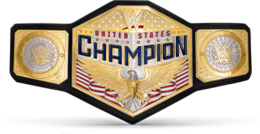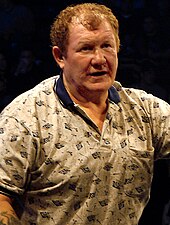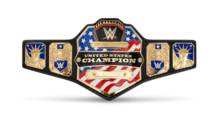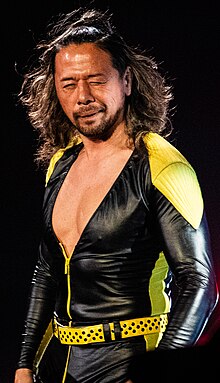WWE United States Championship
| WWE United States Championship | |||||||||||||||||||
|---|---|---|---|---|---|---|---|---|---|---|---|---|---|---|---|---|---|---|---|
 The current WWE United States Championship belt with default side plates (2020–present) | |||||||||||||||||||
| Details | |||||||||||||||||||
| Promotion | Jim Crockett Promotions (1975–1988) World Championship Wrestling (1988–2001) WWE (2001; 2003–present) | ||||||||||||||||||
| Brand | SmackDown | ||||||||||||||||||
| Date established | January 1, 1975 | ||||||||||||||||||
| Current champion(s) | Shinsuke Nakamura | ||||||||||||||||||
| Date won | November 30, 2024 | ||||||||||||||||||
| Other name(s) | |||||||||||||||||||
| |||||||||||||||||||
| |||||||||||||||||||
The WWE United States Championship is a men's professional wrestling championship promoted by the American promotion WWE, defended on the SmackDown brand division. It is one of two secondary championships for WWE's main roster, along with the WWE Intercontinental Championship on Raw. The reigning champion is Shinsuke Nakamura, who is in his third reign. He won the title by defeating LA Knight at Survivor Series: WarGames on November 30, 2024.
The championship was established on January 1, 1975, as the version of the NWA United States Heavyweight Championship that was defended in Jim Crockett Promotions, and later assumed by World Championship Wrestling (WCW), which eventually seceded from the National Wrestling Alliance (NWA). Harley Race was the inaugural champion. After WCW was purchased by the then-World Wrestling Federation (WWF) in 2001, the then-WCW United States Championship was defended in the WWF until it was unified with the Intercontinental Championship at that year's Survivor Series. After the 2002 brand extension and the promotion being renamed WWE, the championship was reactivated as the WWE United States Championship in July 2003 as a secondary title of the SmackDown brand. The United States Championship has switched between brands over the years, usually as a result of the WWE Draft; the 2023 draft moved the title back to SmackDown.
Of WWE's currently active championships, the United States Championship is the only one that did not originate in the promotion. It is the second-oldest active title in the company, behind the WWE Championship (1963), but the third longest-tenured championship, behind the WWE and Intercontinental Championships (1979), as WWE has only owned the United States Championship since 2001.
History
[edit]
The United States Championship began as a regional championship called the NWA United States Heavyweight Championship, one of several versions of the title allowed in different territories under the National Wrestling Alliance (NWA) bylaws. It was created by and defended in Mid-Atlantic Championship Wrestling (MACW) run by Jim Crockett Jr. Introduced on January 1, 1975, Harley Race became the inaugural champion.[1] The title quickly replaced the NWA Mid-Atlantic Heavyweight Championship as the top singles title in the promotion. While the NWA recognized only one World Heavyweight Champion, there was no single undisputed United States Champion as a number of NWA regional promotions recognized their own version of the title and champion. That changed, however, in January 1981; San Francisco-based NWA territory Big Time Wrestling, which was the last remaining promotion outside the Mid-Atlantic territory that recognized its own United States Champion, ceased operations around that time, leaving the Mid-Atlantic version as the only remaining United States Championship.
The title remained the primary championship within the Mid-Atlantic territory until 1986 when Crockett gained control of the NWA World Heavyweight Championship. The United States title then became the secondary championship of the promotion. After Ted Turner bought the company and renamed it World Championship Wrestling (WCW) in November 1988, the title continued to be used and recognized as secondary to the World Championship. WCW began to pull itself away from the NWA, demonstrated by the company changing the name of the title to the WCW United States Heavyweight Championship in January 1991.
On the April 6, 1991, episode of World Championship Wrestling, Nikita Koloff destroyed the classic 1980s United States Heavyweight Championship belt during a post-match brawl with Lex Luger, who was in his fourth reign as champion. Koloff, who claimed to be the true champion, knocked Luger unconscious by striking him with the title belt and then repeatedly smashed the championship belt into a ringpost. Luger would appear without a physical championship belt, and later became the first to wear a newly designed belt, which was used up through WCW's closing in March 2001, after being purchased by rival promotion, the then-World Wrestling Federation (WWF).[2]
When WWF purchased WCW, they used the United States title during the WWF's Invasion storyline. The title was deactivated after being unified with the then-WWF Intercontinental Championship at that year's Survivor Series, when United States Champion Edge defeated Intercontinental Champion Test, becoming the new Intercontinental Champion. In July 2003, a year after the first brand extension went into effect in the promotion renamed World Wrestling Entertainment (WWE), the title was reactivated as the WWE United States Championship by then-SmackDown! General Manager Stephanie McMahon and with a completely new belt design. It was commissioned to be a secondary championship for the SmackDown! brand, making the championship the only one from WCW to be reactivated as a WWE title (although the WCW Cruiserweight Championship had also become a WWE title, it was not deactivated and reactivated; it replaced the WWF Light Heavyweight Championship during the Invasion storyline). Eddie Guerrero became the first champion after its reactivation by winning a tournament at that year's Vengeance, defeating Chris Benoit in the final match. This was done shortly after the Intercontinental Championship was recommissioned by the Raw brand, making the title its equal counterpart. The first brand extension ended on August 29, 2011, allowing the United States Championship, as well as all other titles, to be defended on both Raw and SmackDown.
In 2015, WWE introduced an updated version of its Grand Slam Championship, and the United States Championship became officially recognized as a component of the re-established honor. In August at that year's SummerSlam, United States Champion John Cena faced WWE World Heavyweight Champion Seth Rollins in a Winner Takes All match, which Rollins ultimately won to become the first wrestler to hold the WWE World Heavyweight Championship and United States Championship simultaneously. Rollins held both titles until Cena defeated Rollins in his rematch for the title at Night of Champions the following month.
In July 2016, WWE reintroduced the brand extension; during the draft, United States Champion Rusev was drafted to the Raw brand.[3] Days later, he successfully defended the title against SmackDown draftee Zack Ryder at Battleground, keeping the title exclusive to Raw.[4] On April 11, 2017, United States Champion Kevin Owens, along with the title, moved to SmackDown as a result of that year's Superstar Shake-up. Owens was already scheduled to defend the title against Chris Jericho at the Raw-exclusive pay-per-view Payback on April 30. Then-SmackDown General Manager Daniel Bryan declared that regardless of who won at Payback, the United States Championship would remain on SmackDown; Jericho defeated Owens for the title at Payback and he transferred to SmackDown.[5] During the 2018 Superstar Shake-up, the title briefly returned to Raw when champion Jinder Mahal was drafted to the brand. However, it was immediately returned to SmackDown after Jeff Hardy defeated Mahal for the title and was drafted to SmackDown the next night.[6][7] The championship definitively returned to Raw in 2019 when reigning champion Samoa Joe was drafted to the brand during that year's Superstar Shake-up.[8] During the November 8, 2024, episode of SmackDown, general manager Nick Aldis introduced the women's counterpart to the United States Championship.
Belt design
[edit]
The design of the WCW United States Heavyweight Championship from 1991 to 1995 featured five plates. A center plate on the gold background consisted of a map of the Contiguous United States with a flag shown alongside with an eagle. On top of the plate shows the WCW logo with the two banners reading on the black background "UNITED STATES" along with two stars on each side while the text says "HEAVYWEIGHT WRESTLING CHAMPION" on the bottom. Both side plates on each side feature one with the U.S. flag with the text "UNITED STATES" while the other shows two wrestlers grappling with the WCW logo on top and the text "CHAMPION" on the bottom. After its minor update in 1995, the belt now featured three plates with the center plate slightly redesigned with the side plates also feature a gold filigree with the text "WORLD CHAMPIONSHIP WRESTLING". This belt would also appear on WWF's programming until November 2001.
After its reactivation in July 2003, the newly renamed WWE United States Championship was redesigned. This belt consisted of five plates. The center plate featured a heptagon with a enlarged U.S. flag along with the company's scratch logo located at the top of the main plate in white and black paint. Below the logo is a gold banner with the words “WORLD WRESTLING ENTERTAINMENT” etched inside. In the center of the main plate is a black banner with the words “UNITED STATES CHAMPION” etched in gold. On the bottom of the center plate, the name plate attaches to the main plate by two screws at the back. One of the side plates featured an light etching of an American bald eagle resting on top of a shield with the WWE logo painted white and red within the shield with an eagleholding a red and white striped banner as well as blue-painted square with a white star at the center is placed above the eagle The other side plate featured an portrait of an Statue of Liberty surrounded by four stars on each corner. In August 2014, the United States Championship belt, along with all other pre-existing championship belts in WWE at the time, received a minor update, replacing the long-standing scratch logo with WWE's current logo that was originally used for the WWE Network that launched earlier that year in February.[9][10]
On the July 6, 2020, episode of Raw, after 17 years since the title's reactivation, MVP introduced a completely new belt design for the United States Championship. The belt now features only three plates. The center plate is an upside down heptagon. The top portion of the center plate features the WWE logo flanked by white stars on a gold background. Below this, "UNITED STATES" is written in red, with "CHAMPION" prominently written below that in blue; eight stars divide the two. Below the word champion is an eagle with its wings spread out across the plate, with the red and white stripes of the American flag beneath its wings. Coming in line with WWE's other championship belts, the belt features two side plates with a removable center section that can be customized with the champion's logos; the default side plates consist of a gold WWE logo over a silver globe.[11]
Custom designs
[edit]- In 2000, Lance Storm won the title and unofficially renamed it as the Canadian Heavyweight Championship, complete with large Canadian flag stickers that covered the belt's faceplates.
- Throughout John Cena's reign in 2004 and 2005, a spinner belt of this title was used during his championship run to fit his hip-hop persona at that time.
- During LA Knight's reign in October 2024, he introduced his own custom version, featuring his "LA" logo in white all along the black strap.[12]
Brand designation history
[edit]Following the revival of the United States Championship in 2003, the title was designated to SmackDown. The brand extension was discontinued on August 29, 2011, but it was revived on July 19, 2016. The following list indicates the transitions of the United States Championship between the Raw, SmackDown, and ECW brands.
| Date of transition | Brand | Notes |
|---|---|---|
| July 27, 2003 | SmackDown! | The former WCW United States Championship was reactivated as the WWE United States Championship to be SmackDown!'s secondary title and the counterpart to Raw's Intercontinental Championship. |
| June 23, 2008 | ECW | United States Champion Matt Hardy was drafted to ECW during the 2008 WWE Draft. |
| July 20, 2008 | SmackDown | The United States Championship was returned to SmackDown after Shelton Benjamin, a member of the SmackDown brand, defeated Matt Hardy to win the United States Championship. |
| April 13, 2009 | Raw | United States Champion Montel Vontavious Porter was drafted to Raw during the 2009 WWE Draft. |
| April 26, 2011 | SmackDown | United States Champion Sheamus was drafted to SmackDown during the 2011 WWE Draft. |
| May 1, 2011 | Raw | The United States Championship was returned to Raw after Kofi Kingston, a member of the Raw brand, defeated Sheamus to win the United States Championship. |
| August 29, 2011 | N/A | End of first brand extension. The United States Champion could appear on both Raw and SmackDown. |
| July 19, 2016 | Raw | Reintroduction of the brand extension. United States Champion Rusev was drafted to Raw during the 2016 WWE Draft. |
| April 11, 2017 | SmackDown | United States Champion Kevin Owens was drafted to SmackDown during the 2017 WWE Superstar Shake-up. |
| April 16, 2018 | Raw | United States Champion Jinder Mahal was drafted to Raw during night one of the 2018 WWE Superstar Shake-up. |
| April 17, 2018 | SmackDown | The United States Championship was returned to SmackDown after Jeff Hardy, who had defeated Jinder Mahal to win the title, was drafted to SmackDown during night two of the 2018 WWE Superstar Shake-up. |
| April 22, 2019 | Raw | United States Champion Samoa Joe was drafted to Raw during the 2019 WWE Superstar Shake-up. |
| May 8, 2023 | SmackDown | United States Champion Austin Theory was drafted to SmackDown during the 2023 WWE Draft. |
Tournaments
[edit]WWE United States Championship Tournament (2003)
[edit]The tournament for the vacant WWE United States Championship was held between June 19 and July 27, 2003 for the SmackDown! brand, with the final being at Vengeance (2003).
| Quarterfinals | Semifinals | Final | ||||||||||||
| Chris Benoit | Sub | |||||||||||||
| Rhyno | ||||||||||||||
| Chris Benoit | Sub | |||||||||||||
| Matt Hardy | ||||||||||||||
| Matt Hardy | Pin | |||||||||||||
| Rikishi | ||||||||||||||
| Chris Benoit | 22:14 | |||||||||||||
| Eddie Guerrero | Pin | |||||||||||||
| Billy Gunn | Pin | |||||||||||||
| John Cena | ||||||||||||||
| Billy Gunn | ||||||||||||||
| Eddie Guerrero | Pin | |||||||||||||
| Eddie Guerrero | Pin | |||||||||||||
| Último Dragón | ||||||||||||||
WWE United States Championship Tournament (2017–18)
[edit]At Clash of Champions 2017, Dolph Ziggler won the United States Championship by defeating defending champion Baron Corbin and Bobby Roode in a triple threat match.[13] On the following episode of SmackDown Live, after recapping all of his previous accolades, Ziggler said that the WWE Universe did not deserve him and he dropped the title in the ring and left.[14] After unsuccessful attempts at contacting Ziggler, SmackDown General Manager Daniel Bryan declared the title vacant and announced a tournament to crown a new champion.[15] The final was originally scheduled to occur at the 2018 Royal Rumble, but was moved up to the January 23 episode of SmackDown Live. However, on the January 16 episode, after Jinder Mahal and Bobby Roode won their respective semifinals matches, Roode challenged Mahal to have the final that night and Bryan scheduled it for that episode's main event.[16]
| First round SmackDown Live (12/26/17,[15] 1/2/18,[17] 1/9/18[18]) | Semifinals SmackDown Live (1/16/18[16]) | Final SmackDown Live (1/16/18[16]) | ||||||||||||
| Bobby Roode | Pin | |||||||||||||
| Baron Corbin | 10:44 | |||||||||||||
| Bobby Roode | Pin | |||||||||||||
| Mojo Rawley | 3:05 | |||||||||||||
| Zack Ryder | 4:34 | |||||||||||||
| Mojo Rawley | Pin | |||||||||||||
| Bobby Roode | Pin | |||||||||||||
| Jinder Mahal | 5:32 | |||||||||||||
| Tye Dillinger | 8:41 | |||||||||||||
| Jinder Mahal | Pin | |||||||||||||
| Jinder Mahal | Pin | |||||||||||||
| Xavier Woods | 3:05 | |||||||||||||
| Xavier Woods | Pin | |||||||||||||
| Aiden English | 5:25 | |||||||||||||
Reigns
[edit]
The inaugural champion was Harley Race. There have been 103 different champions, with Ric Flair having the most reigns at six.[1] The longest-reigning champion is Lex Luger, who held the title for 523 days from May 22, 1989, to October 27, 1990. "Stunning" Steve Austin's second reign was the shortest, lasting approximately five minutes. Dean Ambrose is the longest-reigning champion under the WWE banner at 351 days, lasting from May 19, 2013, to May 5, 2014. Booker T and Seth Rollins are the only two men to have held both the United States Championship and a world championship simultaneously; in Booker T's case, the world title was the WCW World Heavyweight Championship, while Rollins held the WWE World Heavyweight Championship (both Lex Luger and Goldberg were the United States Champion when they won their first world championship, but unlike Booker T and Rollins, they vacated the United States Championship after winning their world championships). Terry Funk is the oldest champion in the title's history, winning the title at the age of 56 on September 22, 2000, while David Flair is the youngest at the age of 20 on July 5, 1999. Between NWA/WCW and WWE, the title has been vacated 21 times.
Shinsuke Nakamura is the reigning champion in his third reign. He defeated LA Knight at Survivor Series: WarGames on November 30, 2024, in Vancouver, British Columbia, Canada.[19]
Notes
[edit]- ^ 522 days as recognized by WWE.
See also
[edit]- Secondary championships in WWE
- WWE Women's United States Championship
- WWWF United States Tag Team Championship
References
[edit]- ^ a b "WWE United States Championship Title History". WWE. Archived from the original on 2012-04-22. Retrieved 2009-01-02.
- ^ Picarello, Robert (2002). Monsters of the Mat. The Berkley Publishing Group. pp. 128–130. ISBN 042518594X.
- ^ WWE.com Staff (July 19, 2016). "2016 WWE Draft results: WWE officially ushers in New Era". WWE. Archived from the original on July 20, 2016. Retrieved July 19, 2016.
- ^ Caldwell, James (July 24, 2016). "7/24 WWE Battleground Results – CALDWELL'S Complete Report". Pro Wrestling Torch. Archived from the original on July 27, 2016. Retrieved July 24, 2016.
- ^ Keller, Wade (April 11, 2017). "Keller's WWE SmackDown Report 4/11: Superstar Shake-up Night 2 details". Pro Wrestling Torch. Archived from the original on April 12, 2017. Retrieved April 11, 2017.
- ^ Powell, Jason (April 16, 2018). "WWE Raw Live TV Review: The Superstar Shakeup Night One, Sasha Banks vs. Bayley, Matt Hardy and Bray Wyatt vs. The Revival for a shot at the vacant Raw Tag Titles". Pro Wrestling Dot Net. Archived from the original on April 17, 2018. Retrieved April 16, 2018.
- ^ Keller, Wade (April 17, 2018). "Keller's WWE SmackDown Report 4/17: Superstar Shake-up concludes, tracking which Raw wrestlers will be added to Smackdown roster". Pro Wrestling Torch. Archived from the original on February 17, 2023. Retrieved April 17, 2018.
- ^ Powell, Jason (April 22, 2019). "4/22 WWE Raw Results: Powell's review of the first episode following the WWE Superstar Shakeup". Pro Wrestling Dot Net. Archived from the original on June 4, 2019. Retrieved April 23, 2019.
- ^ Graser, Marc (August 15, 2014). "WWE Rebrands With New Logo Tied to Digital Network". Variety. Archived from the original on August 18, 2014. Retrieved April 16, 2024.
- ^ Powell, Jason (July 6, 2020). "7/6 WWE Raw Results: Powell's live review of Raw Women's Champion Asuka vs. Smackdown Women's Champion Bayley in a non-title match, Rey Mysterio and Aleister Black vs. Seth Rollins and Murphy, Big Show and The Viking Raiders vs. Randy Orton, Andrade, and Angel Garza". Pro Wrestling Dot Net. Archived from the original on July 8, 2020. Retrieved July 7, 2020.
- ^ Jenkins, H (July 7, 2020). "New WWE United States Title Design revealed". Ringside News. Archived from the original on July 8, 2020. Retrieved July 8, 2020.
- ^ LA Knight [@RealLAKnight] (October 25, 2024). ""The Champion makes the title" #SmackDown" (Tweet). Retrieved October 26, 2024 – via Twitter.
- ^ Powell, Jason. "Powell's WWE Clash of Champions 2017 live review: AJ Styles vs. Jinder Mahal for the WWE Championship, Kevin Owens and Sami Zayn put their WWE careers on the line vs. Randy Orton and Shinsuke Nakamura with Shane McMahon and Daniel Bryan as referees". Pro Wrestling Dot Net. Archived from the original on December 22, 2017. Retrieved December 17, 2017.
- ^ Keller, Wade (December 19, 2017). "KELLER'S WWE SMACKDOWN REPORT 12/19: Daniel Bryan and Shane McMahon fallout from Clash of Champions, Shinsuke & Orton & Styles vs. Sami & KO & Jinder". Pro Wrestling Torch. Archived from the original on December 22, 2017. Retrieved December 20, 2017.
- ^ a b Barnett, Jake. "12/26 Barnett's WWE Smackdown Live TV Review: WWE Champion AJ Styles vs. Kevin Owens, the final edition of 2017". Pro Wrestling Dot Net. Archived from the original on December 27, 2017. Retrieved December 26, 2017.
- ^ a b c Keller, Wade. "KELLER'S WWE SMACKDOWN REPORT 1/16: U.S. Title Tournament semi-finals with Xavier vs. Jinder, Roode vs. Mojo, Shane-Bryan drama continues". Pro Wrestling Torch. Archived from the original on January 17, 2018. Retrieved January 16, 2018.
- ^ Barnett, Jake (January 2, 2018). "01/02 Barnett's WWE Smackdown Live TV Review: WWE Champion AJ Styles vs. Sami Zayn in a non-title match, The Usos vs. Shelton Benjamin and Chad Gable for the Smackdown Tag Titles, U.S. Title tournament continues on the first Smackdown of 2018". Pro Wrestling Dot Net. Archived from the original on January 3, 2018. Retrieved January 3, 2018.
- ^ Barnett, Jake. "01/09 Barnett's WWE Smackdown Live TV Review: AJ Styles addressed handicap match title defense at the Royal Rumble, U.S. Title tournament continues, Bludgeon Brothers vs. The Ascension, Ruby Riott vs. Becky Lynch". Pro Wrestling Dot Net. Archived from the original on January 10, 2018. Retrieved January 9, 2018.
- ^ Mendoza, Jordan; Williams, James H. (November 30, 2024). "WWE Survivor Series: WarGames 2024 live results: Winners, highlights and analysis". USA Today. Archived from the original on December 2, 2024. Retrieved November 30, 2024.
